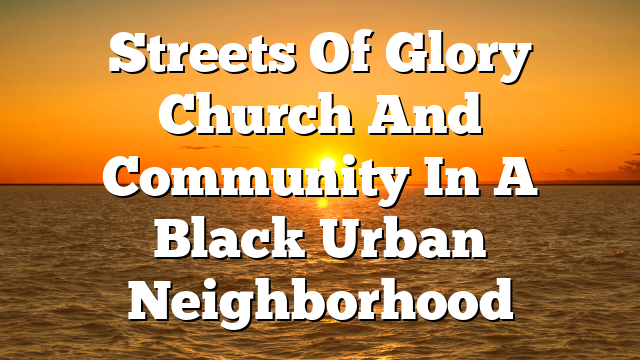Book Reviews / Pneuma 31 (2009) 105-160
131
Omar M. McRoberts, Streets of Glory: Church and Community in a Black Urban Neighbor- hood (Chicago and London: The University of Chicago Press, 2003). x +186 pp. $17.50, paper.
Streets of Glory is a product of the author’s Harvard University dissertation work in the fi eld of sociology. It focuses on the religious district of Four Corners located in the Dorchester neighborhood of Greater Boston. When Jews and most whites moved out of Four Corners in the sixties, African Americans displaced by urban renewal in Roxbury resettled the area. Later, Caribbeans and Latinos moved in; however, Four Corners has remained pre- dominantly African American, crime-ridden, and poor. Most of its twenty-nine congrega- tions worshipped in storefronts, claimed a Pentecostal/Apostolic afiliation, and catered to African Americans, English-speaking West Indians, Haitians, and Latinos. Most of the congregations’ constituents were working class while professionals formed the core of six congregations. The religious district caught the attention of McRoberts because it con- tained more congregations per square mile than the next densest neighborhood. McRoberts’ research seeks answers to the following three questions: 1) Why do some poor neighborhoods contain so many churches, and how do these neighborhoods sustain so much religious activity? 2) How do churches in poor neighborhoods vary as social insti- tutions? And 3) How do churches relate to community eff orts to address neighborhood problems? McRoberts identifi es the availability of cheap vacant properties as the primary reason why Four Corners reports so many churches. Congregations moved from Codman Square, Mattapan, Roxbury, and Jamaica Plain to take advantage of the cheap commercial storefronts of Four Corners made available by white fl ight. Four Corners congregations functioned as niche churches because they drew their members from outside and did not compete for neighborhood residents.
In tackling the issue of community involvement, McRoberts found that all the churches practiced “activism,” including personal transformation, socialization, and social transforma- tion. Unlike scholars who claim that churches that do little for nonmembers are nonactivist, McRoberts argues that most of the Four Corners congregations practiced “trickle-down” spiritual activism. Ministers believed that social transformation could be best accomplished by secular agencies and that socialization of members, the giving of skills and knowledge for coping with social problems, was what their churches could do best. Ministers encouraged their members to vote and empowered parishioners by reminding them that they have the power of God available to them; therefore, they should face the challenges of society with a positive outlook. Worship created communitas through glossolalia, ecstatic shouting, and dancing. Immigrant churches were far more “complete” than native churches, that is, they off ered more social services to their members because the latter did not take advantage of secular programs. To their parishioners, immigrant churches provided job referrals, assistance with rent, and information about immigration and naturalization.
Five congregations were deemed prophetic because they developed direct attempts at social transformation. T ree of the fi ve belonged to the Pentecostal/Apostolic family: Azusa Christian Community, Jude Church, and Holy Road Church. Azusa developed a variety of activities including a tutoring and job placement service, street outreach, court advocacy, and music and sports activities. Eugene Rivers, Azusa’s pastor, patrolled the streets to invite
© Koninklijke Brill NV, Leiden, 2009 DOI: 10.1163/157007409X418301
1
132
Book Reviews / Pneuma 31 (2009) 105-160
prostitutes and gang members to register for his programs. Holy Road initiated an after- school program, a summer camp, basketball games, and block parties in an attempt to minister to local young people. Pastor Barbara Calvin, of Jude, founded Citizens Against Homicide, a counseling center for the parents of murdered children. McRoberts explained the involvement of the prophetic pastors by their exposure to the civil rights movement and their ability to muster a new Pentecostal hermeneutics enabling them to minister to the whole person (body and soul). This Pentecostal activism disproves numerous studies on white and black churches that link lack of interest in social transformation to theological conservatism.
One merit of Streets of Glory is reminding the academy that Pentecostals storefronts remain a reality in urban America despite the recent scholarly and popular interest in mega- churches. McRoberts does a good job at showing that storefronts are not as otherworldly as previous thought. The poor speak in tongues, are empowered through worship to tackle life’s problems, and then go to the voting booth. Streets of Glory shows that previous studies on black storefronts by Horace Cayton, St. Clair Drake, and Franklin Frazier are now out- dated. McRoberts’s fi ndings also corroborate the not-well-known fact that political involve- ment by black denominational leaders on the national front does not necessarily translate into activism toward social transformation at the local level.
One criticism, however, is the reliance on studies of white churches in discussing the impact of doctrines on black church activism. In Bishop C.H. Mason and the Roots of the Church of God in Christ (1996), Ithiel C. Clemmons asserts that various Pentecostal minis- ters participated in the civil rights movement of the sixties; therefore, McRoberts should not take black Pentecostal activism as something that is just emerging. Another criticism is that McRoberts did not clearly address how Four Corners sustained so much religious activity (the second part of the second question). Likewise, he did not clarify why congrega- tions did not recruit new converts from the Four Corners area, especially when those churches carried a small membership. Nevertheless, Streets of Glory remains a useful tool for the understanding of the continuing existence of storefronts.
Reviewed by David Michel
2

Leave a Reply